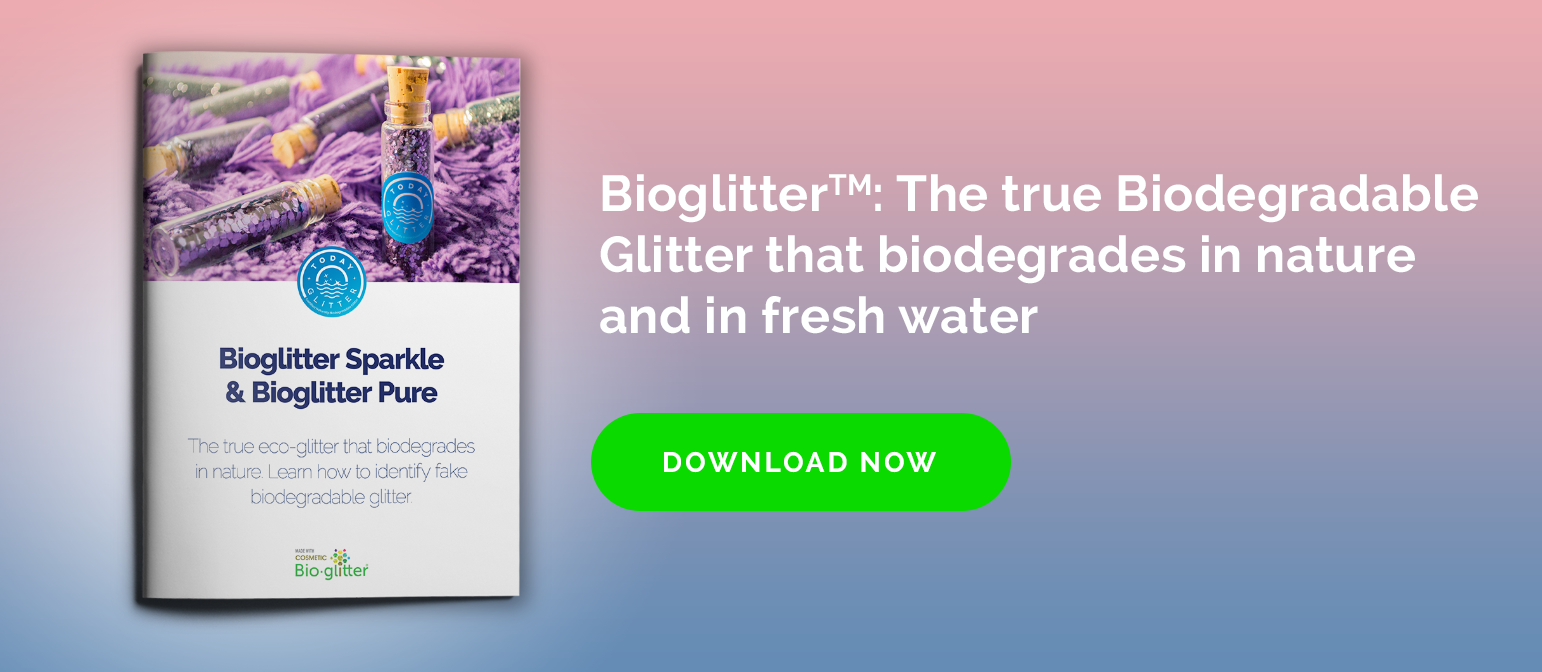How to Spot Fake Biodegradable Glitter?
You may think you are doing good for the environment buying a so-called “biodegradable” glitter, but does it really biodegrade in nature? Read this article to know how to be sure you are actually getting an eco-friendly alternative. We have removed all the guesswork for you to choose the right one!
Many new types of glitter are being developed to tackle the micro-plastic pollution, in which traditional plastic-based glitter plays an important role, but claiming to be “biodegradable” is not good enough. It has to be proven your glitter does biodegrade in the natural environment to be sure you are getting an actual biodegradable glitter.
Some of the following alternatives to plastic-based glitter are being launched to the marked:
Compostable glitter
PLA glitter
Cellophane-based glitter
Cellulose acetate glitter
They all claim to be biodegradable products and that they can replace standard glitter, but here you will learn why you cannot trust them.
Compostable Glitter
Although it is always confused with naturally biodegradable glitter, compostable glitter does not biodegrade in nature. Thinking that compostable glitter is good for the environment is a terrible misconception that needs to be corrected quickly! In order to be recycled, compostable glitter requires specific temperatures, the right pressure and the correct bacteria environment so that it actually biodegrades. Unfortunately, this does not occur in the natural environment making compostable glitter to remain basically unaltered, just like a plastic-based one would normally do. We would need to pick every little glitter particle and take it to a compostable plant so that this type of glitter can decompose, which is impossible since glitter very often gets washed off in the sink or shower and then it goes down the drain. That is why compostable glitter is essentially useless.
PLA Glitter
Is PLA compostable and biodegradable? Many people wonder about that, but you should know that PLA (polylactic acid) is actually pretty bad. It is a polymer made from high levels of polylactic acid molecules, the polymer needs water to be broken up and make PLA compostable and biodegradable in a process called hydrolysis. Also, hydrolysis needs high temperature and moisture to be able to occur, otherwise PLA items will not biodegrade; they need to be exposed to heat and moisture. They can remain unchanged for decades and centuries like micro-plastics. A composting infrastructure has to be set up to regenerate the bio-material because without connecting the use of PLA with the ability to recover the bio-material we are not doing any good to the environment, regardless of what many can claim.
Cellophane-based glitter
Before you make any attempt to buy this type of glitter, you should know that cellophane does not have good enough biodegradability to even get certified. Although it has been around for years, cellophane-based glitter cannot get certified to biodegrade because of its chemical structure.
Cellulose acetate
Cellulose acetate is the same ingredient used to make cigarette butts… Do you really need to know more? Would you expose your skin to an ingredient used in cigarettes?
What new type of glitter can you trust then?
An environmentally friendly alternative was manufactured to specifically attack the micro-plastic pollution; it replaces core polyester film normally used in conventional glitter with cellulose from hardwoods of eucalyptus.
Bioglitter is a unique type of glitter that uses plant-derived regenerated eucalyptus cellulose. It is the only glitter proven to biodegrade into harmless particles once it gets in contact with the natural environment.
In order to prove it is actually naturally biodegradable, Bioglitter had to pass the fresh water test, which is the only way to guarantee a product biodegrades in nature.
Bioglitter mainly has two goals:
To be 100% plastic-free
To be biodegradable in the natural environment
Bioglitter is winning very important awards in the cosmetic industry. For instance, its newest product – Bioglitter PURE (available as of March 2019) – has won the Gold Award Cosmetic Bar Innovation in 2018 for being 100% plastic-free the same award Bioglitter SPARKLE won in 2017 for being 92% plastic-free. Bioglitter is always innovating.
Where can you get Bioglitter?
Today Glitter is proud to be the first and only reseller of Bioglitter in the US; you can find any of its award-winning products when you get in contact with Today Glitter. Bioglitter is the only glitter that can guarantee you are actually helping the environment.



Can you cite your sources? Of course you are going to say your product does this so much better than these other guys. Also where can we find the evidence of the claims of your product being the only glitter product to help the environment?
Hello, would this glitter break down in water alone? How long would it take? Thanks!
Where can I find the ingredient list on your products? What dyes are used, etc?